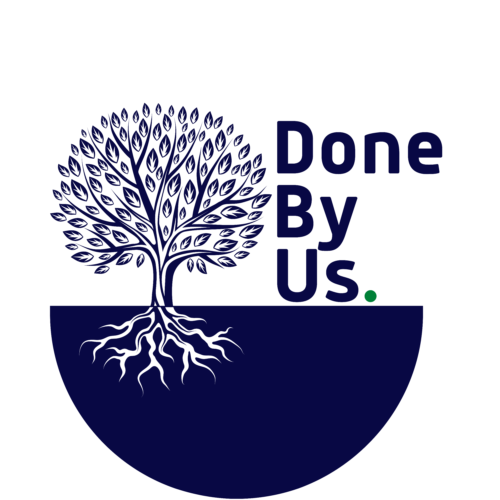
By: King Adawu Wellington (email: kingawellington@gmail.com)
The notion that the world is a global village is not a fallacy in today’s world. Businesses do not exist in isolation and are impacted by factors beyond their control. In fact what happens in one country and continent may have an effect on businesses in another country. Think of how manufacturing companies in China lost production demands after COVID-19 because countries and their global sourcing companies realised that they were over reliant on China for manufacturing hence took a decision to diversify were they produce their products.
In business, success is largely dependent on choices made by leaders in every given situation; therefore there must be constant adjustments to business decisions by continuously analysing business environment in order to sustain operations. Similar to what happened to the manufacturing companies in China, the emergence of COVID-19 which emanated from the external business environment caused most businesses to close down. Likewise Brexit, another incident emanating from external business environment brought about both opportunities and threats to businesses. In the late nineties, Nokia lost market share due to technological shifts and changes which they failed to adjust, simply put, Nokia’s competitors evolved and Nokia didn’t. In a similar vein, due to technological advancement, political and economic reforms, and reduction of protectionist policies, global consumers now buy and sell goods from the comfort of their homes creating huge opportunities for companies such as Amazon and Alibaba.
The aforementioned examples clearly indicates the transformation power and impact that external business environment has on organizations. This impact can either have a positive or negative effect on a company’s overall output hence expounding the multi-dimensionality of these external factors and the fact that it is outside the control of companies.
According to business literature, external business environment is categorized by three factors: complexity, sudden shifts of factors which can be in favour or against an organization and fierce rivalry. These dimensions create high uncertainty thereby making predictability difficult. It is therefore prudent for businesses to understand the likely threats and opportunities facing them and be able to develop strategic capabilities and formulate strategies in order to use external factors in a way that will be beneficial to them.
External micro and macro environments are the general classification given to the external business environment. The external micro environment consists of factors that affect a company’s activities based on its operations and industry. On the other hand, external macro environment consist of factors that are far reaching to an organization hence businesses do not have control over these factors. Although this categorization is often used, it is not consistent across the business community because of the wide range of classification that exist. This phenomenon has triggered businesses to continuously analyze, prepare and adjust to take advantages of opportunities or curtail threats presented by external environment.
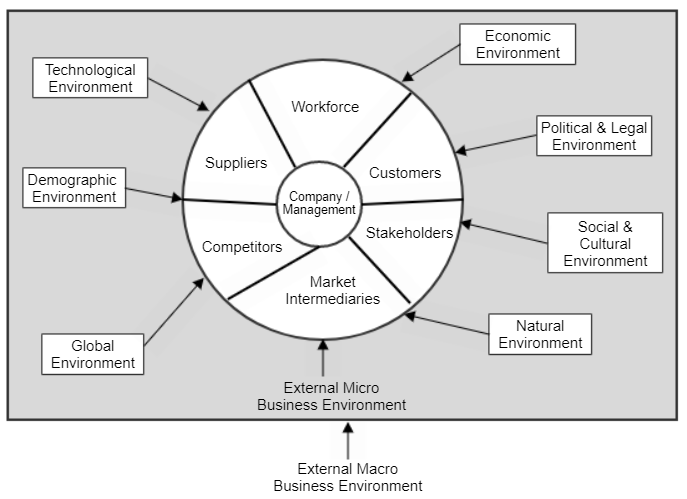
Figure 1.0: External micro and macro factors
Emphasizing on the six factors that constitutes the external micro environment illustrated in Figure 1.0, businesses rely on inputs – transforming or transformed resources – such as raw material and information in order to produce products or services for consumers. This makes suppliers key micro-level factor that can have an adverse impact on businesses. Over reliance on one supplier is risky because any disruption in the supplier’s operation can affect a company’s input resources. Furthermore without customers it will be unlikely for any business to generate revenue and be sustainable hence it is in the interest of a company to keep its customers satisfied. Likewise, competition plays a key role in business survival. Businesses want to capture higher market share, have the best product and even offer the best price to consumers in most cases thereby increasing competition. Market intermediaries such as agents and distributors are essential to most businesses and their actions affect business operations. For example in Ghana, UBER’s service was almost interrupted because drivers who are market intermediaries of UBER refused to continue offering services due to poor treatment from the company. Finally, stakeholders affect or are affected directly or indirectly by a company’s operations. Media, unions, government and civil society organizations are all part of a company’s stakeholders hence failure to properly manage these groups appropriately will affect the company negatively.
Furthermore, how an economy is structured, the fiscal and legal systems adopted by a country affect businesses operating in the country. Let’s take for instance laws in Ghana prohibit foreigners to engage in retailing in the country. This economic reform negatively affected traders from neighbouring countries who had already invested in retail business across Ghana assuming they established before the law was enacted. Think of how the African Continental Free Trade Area (AfCFTA) will also affect both new and existing players in each sector. Furthermore, political philosophy of a government as well as legal structures equally has an impact on a business. For example, liberalists favour free market while socialists aim to provide equal opportunities for all. Technology is also a macro-level factor that affects businesses. Technological advancement is geared towards improving operational efficiencies, achieving competitive advantage and creating frontier opportunities. Companies that take advantage of technology continue to stay in business. For instance, DVD and MP3 players’ manufacturers that failed to evolve during emergence of smart consumer electronics such as phones and televisions went out of business. Again, a country’s population dynamics such as size, gender composition, educational level, life expectancy rate, mortality rate and rural-urban migration mix forms part of the demographic macro-level environment. These factors affect businesses on all levels. This is because, when a country has youthful and educated population, businesses have skilled and qualified labour force to utilize. Likewise, an aged population can be beneficial or a handicap to businesses depending on the products or services offered.
In line with the above, businesses must develop or adopt frameworks and techniques to analyse and manage uncertainties of both micro and macro environmental factors. Figure 2 is an illustration of some existing tools that can be adopted.
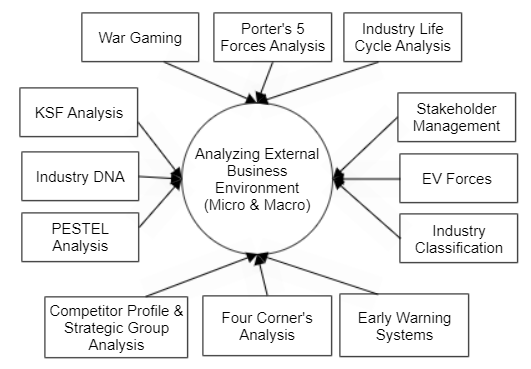
Figure 2.0: Tools to analyze external environment
Using tools to analyse business environment ensures systematic and critical interpretation of happenings to predict future occurrences. It is argued that elucidating findings after analysing a company’s environment should be void of any prejudice. PESTEL analysis is the most basic framework used by strategists and it’s effective in analysing macro factors. Specifically, it is used to appraise political, economic, socio-cultural, technological, environment and legal factors of a market. Furthermore, to determine possible success of products or services, companies use Porter’s Five Forces to assess their competitive strengths and position thereby understanding the five key competitive forces – namely suppliers and buyers influence, level of competition and threats, new entrants and substitutes – that drives strategy is critical to success. Figure 3.0 is a sample competitive analysis of Ghana Oil Company Limited (GOIL) using Porter’s Five Forces.
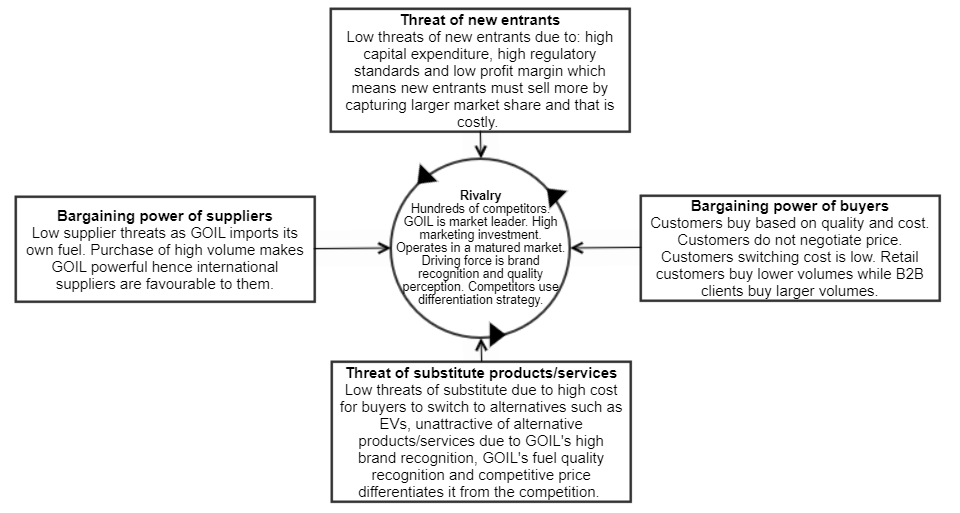
Source: King A. Wellington
Figure 3.0: Porter’s Five Forces Competitive Analysis of GOIL
Another tool is the industry lifecycle analysis, which is useful because companies can set targets and forecast performance based on the phase of an industry, thus whether there is expansion, peak, contraction or trough. Figure 4.0 is a sample analysis of downstream petroleum industry in Ghana.
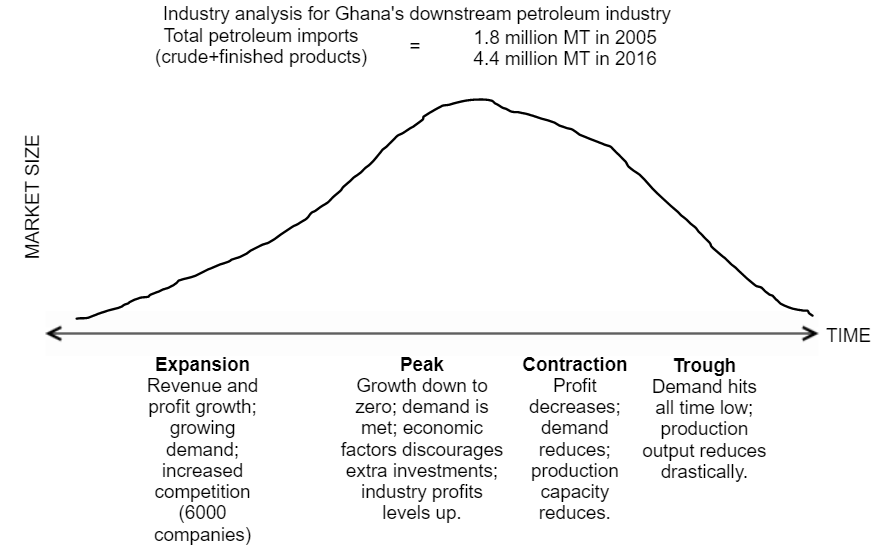
Additionally, often albeit companies analyse external environments and strategize to curtail negativity or take advantage of positive factors, inability of firms to clearly implement these strategizes leads to failure. Adopting a framework such as the strategy diamond shown in Figure 5.0 provides a roadmap to successful strategy implementation.

According to business literature, arenas address key activities regarding markets and location as well as core competences that a company possess. Differentiators deals with exclusivity and distinctiveness of a company. The economic logic segment addresses revenue streams of a company while the vehicle segment deals with the mode of delivery of the strategy. It is prudent for firms to incorporate dynamic measures in their strategies because of the continuous evolvement of external environment and this makes the staging segment significant.
I must admit that most strategies fail hence having a good implementation plan is vital for success. Additionally, I have noticed that due to the high resistance to change, most strategies are unable to be deployed effectively hence it will be good to have a change management framework in place before implementing a strategy.
In conclusion, for businesses to thrive, it is imperative to be aware of the impact of its external business environment and adequately prepare in order to take up opportunities as well as shield the organization from threats thereby gaining more insight and skillset. Businesses must build their competencies to be able to predict future occurrences that can affect them positively or negatively. Finally, as expounded by the contingency theory, business decisions should be multidimensional and based on how businesses position themselves with external environmental factors hence managing a company should be dynamic and not static.
About the writer:
King Adawu Wellington is a business strategist with expertise in executing projects and helping companies achieve their goals in diverse industries.

